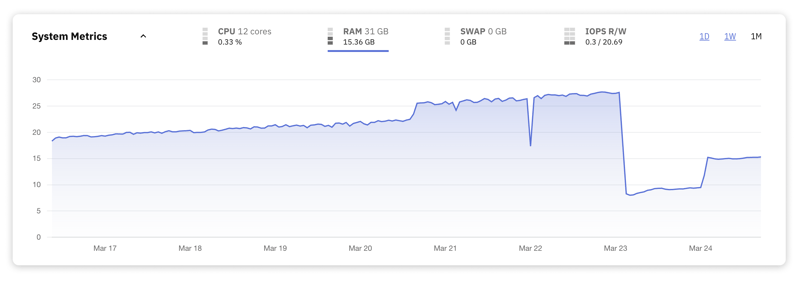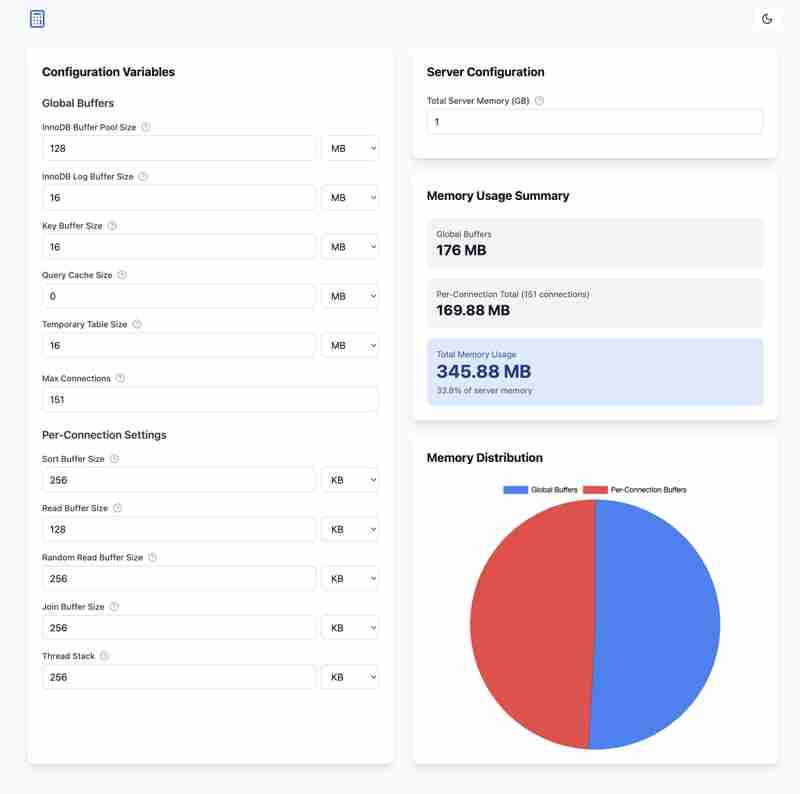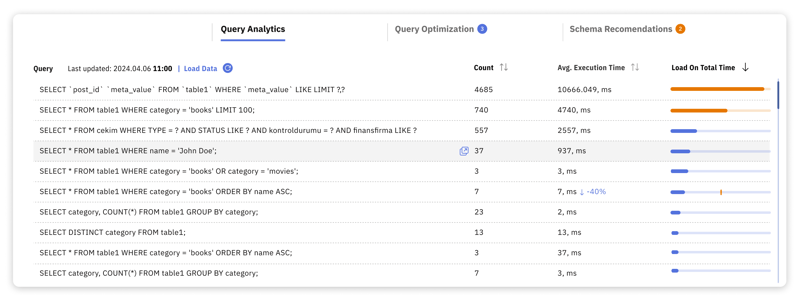MySQL Memory Usage: Optimization Guide
Apr 08, 2025 pm 06:24 PMMySQL Memory Optimization Guide: Avoid Memory Peaks and Improve Database Performance
High MySQL memory usage will seriously affect database speed and reliability. This article will explore the MySQL memory management mechanism in depth and provide best practices to help you optimize performance and avoid memory bottlenecks.

MySQL memory usage analysis
MySQL dynamically allocates memory for handling queries, connections, and performance optimizations. It is mainly divided into two categories:
1. Global buffer: shared by the entire MySQL server, including InnoDB buffer pool, key buffer and query cache, etc. InnoDB buffer pool is particularly important. It caches frequently accessed data and indexes, speeds up query speed, but it will occupy a lot of memory when the data volume is large.
2. Connection (per thread) buffer: Allocate independent memory for each client connection, including sorting buffers, connection buffers, and temporary table memory. The more concurrent connections, the greater the memory consumption, which is particularly critical in high-traffic environments.
Common Causes of MySQL Memory Rises
MySQL memory peaks are usually caused by the following factors:
- High Concurrent Connections and Large Buffers: If the sort or connection buffer is set too large, a large number of concurrent connections can quickly run out of memory.
- Complex queries: Complex queries (large joins, subqueries, or large number of temporary tables) temporarily occupy a lot of memory, especially when query optimization is insufficient.
- InnoDB buffer pool setting is too large: If the InnoDB buffer pool size exceeds the available memory on the server, disk swap will be frequently performed, seriously degrading performance.
- Large temporary tables: When temporary tables exceed memory limit (
tmp_table_size), they will be written to disk, reducing speed and increasing resource consumption. - Inefficient indexing: Lack of appropriate indexes can lead to full table scanning, and even moderately complex queries can increase memory and CPU usage.
MySQL memory optimization best practices
To deal with excessive MySQL memory usage, try the following strategies:
1. Optimize the global buffer:
- Set
innodb_buffer_pool_sizeto 60%-70% of the available memory of InnoDB workloads. For smaller loads, it should be reduced appropriately. - Keep
innodb_log_buffer_sizeat a practical size (e.g. 16MB), unless the write-intensive workload requires more. - Adjust
key_buffer_sizeaccording to the usage of MyISAM table to avoid unnecessary memory allocation.
2. Resize the connection buffer:
- Reduce
sort_buffer_sizeandjoin_buffer_sizeto balance memory usage and query performance, especially in high concurrency environments. - Optimize
tmp_table_sizeandmax_heap_table_sizeto control temporary table memory allocation and avoid frequent disk usage.
3. Fine-tune table cache:
- Adjust
table_open_cacheto avoid bottlenecks while taking into account operating system file descriptor limitations. - Configure
table_definition_cacheto effectively manage table metadata, especially in environments where there are many tables or complex foreign key relationships.
4. Control thread cache and connection restrictions:
- Reuse threads with
thread_cache_sizeto reduce the overhead of creating threads. - Adjust
thread_stackandnet_buffer_lengthto fit the workload while keeping memory usage scalable. - Limit
max_connectionsto a reasonable range to prevent too many session buffers from occupying too much server memory.
5. Monitor and optimize temporary tables:
- Monitor the usage of temporary tables and reduce memory pressure by optimizing queries such as
GROUP BY,ORDER BY, orUNION.
6. Using MySQL Memory Calculator:
- Estimate memory usage using tools such as Releem's MySQL memory calculator. Enter the MySQL configuration value and the calculator will display the maximum memory usage in real time, which will help to allocate resources effectively.

7. Monitor query performance:
- Queries with high memory consumption (large number of joins or sorts, lack of indexing) can affect memory usage. Use Releem's query analysis and optimization functions to identify inefficient queries for further optimization.

Simplify MySQL memory tuning with Releem
Releem simplifies the MySQL optimization process by automatically analyzing settings and suggesting configuration changes that meet memory limitations and performance requirements. Whether it is complex workloads or time-critical situations, Releem can help you keep MySQL running smoothly. To learn more about Releem's features, please visit its official website.
The above is the detailed content of MySQL Memory Usage: Optimization Guide. For more information, please follow other related articles on the PHP Chinese website!

Hot AI Tools

Undress AI Tool
Undress images for free

Undresser.AI Undress
AI-powered app for creating realistic nude photos

AI Clothes Remover
Online AI tool for removing clothes from photos.

Clothoff.io
AI clothes remover

Video Face Swap
Swap faces in any video effortlessly with our completely free AI face swap tool!

Hot Article

Hot Tools

Notepad++7.3.1
Easy-to-use and free code editor

SublimeText3 Chinese version
Chinese version, very easy to use

Zend Studio 13.0.1
Powerful PHP integrated development environment

Dreamweaver CS6
Visual web development tools

SublimeText3 Mac version
God-level code editing software (SublimeText3)
 How to use PHP to develop a Q&A community platform Detailed explanation of PHP interactive community monetization model
Jul 23, 2025 pm 07:21 PM
How to use PHP to develop a Q&A community platform Detailed explanation of PHP interactive community monetization model
Jul 23, 2025 pm 07:21 PM
1. The first choice for the Laravel MySQL Vue/React combination in the PHP development question and answer community is the first choice for Laravel MySQL Vue/React combination, due to its maturity in the ecosystem and high development efficiency; 2. High performance requires dependence on cache (Redis), database optimization, CDN and asynchronous queues; 3. Security must be done with input filtering, CSRF protection, HTTPS, password encryption and permission control; 4. Money optional advertising, member subscription, rewards, commissions, knowledge payment and other models, the core is to match community tone and user needs.
 How to set environment variables in PHP environment Description of adding PHP running environment variables
Jul 25, 2025 pm 08:33 PM
How to set environment variables in PHP environment Description of adding PHP running environment variables
Jul 25, 2025 pm 08:33 PM
There are three main ways to set environment variables in PHP: 1. Global configuration through php.ini; 2. Passed through a web server (such as SetEnv of Apache or fastcgi_param of Nginx); 3. Use putenv() function in PHP scripts. Among them, php.ini is suitable for global and infrequently changing configurations, web server configuration is suitable for scenarios that need to be isolated, and putenv() is suitable for temporary variables. Persistence policies include configuration files (such as php.ini or web server configuration), .env files are loaded with dotenv library, and dynamic injection of variables in CI/CD processes. Security management sensitive information should be avoided hard-coded, and it is recommended to use.en
 How to use PHP to develop product recommendation module PHP recommendation algorithm and user behavior analysis
Jul 23, 2025 pm 07:00 PM
How to use PHP to develop product recommendation module PHP recommendation algorithm and user behavior analysis
Jul 23, 2025 pm 07:00 PM
To collect user behavior data, you need to record browsing, search, purchase and other information into the database through PHP, and clean and analyze it to explore interest preferences; 2. The selection of recommendation algorithms should be determined based on data characteristics: based on content, collaborative filtering, rules or mixed recommendations; 3. Collaborative filtering can be implemented in PHP to calculate user cosine similarity, select K nearest neighbors, weighted prediction scores and recommend high-scoring products; 4. Performance evaluation uses accuracy, recall, F1 value and CTR, conversion rate and verify the effect through A/B tests; 5. Cold start problems can be alleviated through product attributes, user registration information, popular recommendations and expert evaluations; 6. Performance optimization methods include cached recommendation results, asynchronous processing, distributed computing and SQL query optimization, thereby improving recommendation efficiency and user experience.
 How to build an online customer service robot with PHP. PHP intelligent customer service implementation technology
Jul 25, 2025 pm 06:57 PM
How to build an online customer service robot with PHP. PHP intelligent customer service implementation technology
Jul 25, 2025 pm 06:57 PM
PHP plays the role of connector and brain center in intelligent customer service, responsible for connecting front-end input, database storage and external AI services; 2. When implementing it, it is necessary to build a multi-layer architecture: the front-end receives user messages, the PHP back-end preprocesses and routes requests, first matches the local knowledge base, and misses, call external AI services such as OpenAI or Dialogflow to obtain intelligent reply; 3. Session management is written to MySQL and other databases by PHP to ensure context continuity; 4. Integrated AI services need to use Guzzle to send HTTP requests, safely store APIKeys, and do a good job of error handling and response analysis; 5. Database design must include sessions, messages, knowledge bases, and user tables, reasonably build indexes, ensure security and performance, and support robot memory
 How to develop AI intelligent form system with PHP PHP intelligent form design and analysis
Jul 25, 2025 pm 05:54 PM
How to develop AI intelligent form system with PHP PHP intelligent form design and analysis
Jul 25, 2025 pm 05:54 PM
When choosing a suitable PHP framework, you need to consider comprehensively according to project needs: Laravel is suitable for rapid development and provides EloquentORM and Blade template engines, which are convenient for database operation and dynamic form rendering; Symfony is more flexible and suitable for complex systems; CodeIgniter is lightweight and suitable for simple applications with high performance requirements. 2. To ensure the accuracy of AI models, we need to start with high-quality data training, reasonable selection of evaluation indicators (such as accuracy, recall, F1 value), regular performance evaluation and model tuning, and ensure code quality through unit testing and integration testing, while continuously monitoring the input data to prevent data drift. 3. Many measures are required to protect user privacy: encrypt and store sensitive data (such as AES
 How to make PHP container support automatic construction? Continuously integrated CI configuration method of PHP environment
Jul 25, 2025 pm 08:54 PM
How to make PHP container support automatic construction? Continuously integrated CI configuration method of PHP environment
Jul 25, 2025 pm 08:54 PM
To enable PHP containers to support automatic construction, the core lies in configuring the continuous integration (CI) process. 1. Use Dockerfile to define the PHP environment, including basic image, extension installation, dependency management and permission settings; 2. Configure CI/CD tools such as GitLabCI, and define the build, test and deployment stages through the .gitlab-ci.yml file to achieve automatic construction, testing and deployment; 3. Integrate test frameworks such as PHPUnit to ensure that tests are automatically run after code changes; 4. Use automated deployment strategies such as Kubernetes to define deployment configuration through the deployment.yaml file; 5. Optimize Dockerfile and adopt multi-stage construction
 How to use PHP to implement AI content recommendation system PHP intelligent content distribution mechanism
Jul 23, 2025 pm 06:12 PM
How to use PHP to implement AI content recommendation system PHP intelligent content distribution mechanism
Jul 23, 2025 pm 06:12 PM
1. PHP mainly undertakes data collection, API communication, business rule processing, cache optimization and recommendation display in the AI content recommendation system, rather than directly performing complex model training; 2. The system collects user behavior and content data through PHP, calls back-end AI services (such as Python models) to obtain recommendation results, and uses Redis cache to improve performance; 3. Basic recommendation algorithms such as collaborative filtering or content similarity can implement lightweight logic in PHP, but large-scale computing still depends on professional AI services; 4. Optimization needs to pay attention to real-time, cold start, diversity and feedback closed loop, and challenges include high concurrency performance, model update stability, data compliance and recommendation interpretability. PHP needs to work together to build stable information, database and front-end.
 How to build a user feedback system with PHP. PHP feedback collection and processing process
Jul 23, 2025 pm 06:09 PM
How to build a user feedback system with PHP. PHP feedback collection and processing process
Jul 23, 2025 pm 06:09 PM
The database structure design of the user feedback system must include core fields such as id (primary key), user_id (user association), feedback_type (feedback type), message (feedback content), status (processing status), created_at and updated_at (timestamp), to ensure data integrity and scalability; 2. The key steps for PHP to implement feedback submission and verification include: front-end form POST data, first verify (such as empty(), filter_var() check format after receiving PHP scripts (such as empty(), filter_var() check format) and then filter (htmlspecialchars() prevent XSS), and use preprocessing statements (PDO or MySQLi) to prevent S






